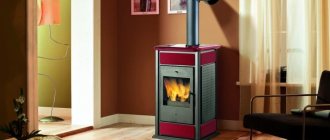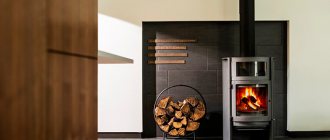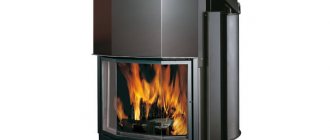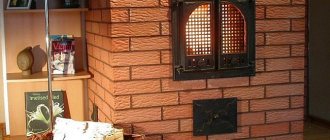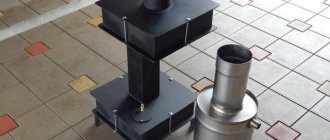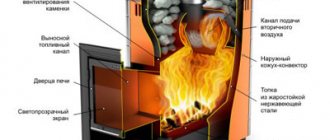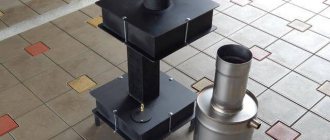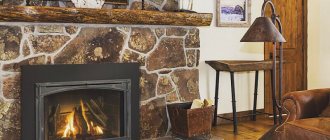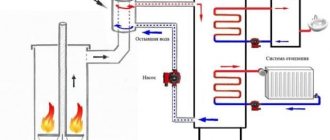What do we usually expect from a fireplace?
When we - you, me or anyone else - sitting in front of a computer screen, drawing our project or just thinking about the topic of heating a house, think about a fireplace and heating a house (especially if we think about the first and second at the same time), we often forget the primary expectations from the fireplace itself.
Firstly, we forget the difference between an open fireplace and a fireplace with a door. And it is significant if the door is ordinary. The fact is that fireboxes come in “grate” and “hearth” types. I recently wrote a separate article about this, “Modern fireplace door with fireproof glass - important features!” Many people know very well what the beauty of open fireplaces is. But it's unlikely that many people can distinguish between the important features of a fireplace insert (or any fireplace with a door) and an open fireplace. And even more so, fewer people will be able to choose a door behind the glass of which the fireplace will burn with the effect of an open fireplace - a good hearth door. The vast majority of steel fireplaces and any fireplaces with doors are grate. This is required for heating efficiency. The combustion in them is completely different; the aesthetics of burning wood in them will never compare with an open fireplace or a fireplace with a good hearth door.
Secondly, here is my personal experience and the experience of my colleagues. In order not to constantly put off starting the fireplace and generally be able to enjoy the view of the flame, the fireplace should be located in the most visible place in the living room. Also, he should not occupy a key place - so as not to get in the way. This is, of course, obvious, but when the question of the water circuit arises, we begin to scroll through the many placement options for profitable home heating. Often, we forget about the above-mentioned obviousness for the sake of heating efficiency.
Is it possible to install a heating register in an existing furnace?
It would be more correct, of course, to build the furnace around the manufactured register. But, if the stove is already standing, you can still build a water circuit into it. True, you will have to try hard - they are of considerable size and must somehow hold on. So the task is not an easy one. In addition, do not forget that you will have to make two more conclusions - to connect the supply and return pipelines.
The best option is to make a water jacket under the shape of the stove (this one is for a metal stove with burners)
Finding a place to locate the register is also not very easy. Its direct contact with fire is very undesirable, but it should be in an environment of hot gases. In this case, you can hope that the heat exchanger will last a long time.
The truth about iron fireplaces with a water circuit or - 5 reasons not to do it
It must be said that the calculation of the power of cast iron fireboxes is very unique. To say that such calculations are slightly overestimated is to say nothing. Moreover, when such a firebox with a water circuit is taken into account. Let me make a reservation right away that I am not taking into account real direct or long-burning boilers designed for heating a house. I wrote about them in a separate article (the link will open in a new tab).
- Firstly, when calculating the power of a cast-iron fireplace insert, they simply can (most often do) not take into account the efficiency!
- Secondly, they can write the calculated power not as the average daily one (for “so-and-so” furnaces for “so-and-so” time). Since I and the vast majority of stove-makers calculate the power of our heating products - but the instantaneous one. This, in general, is the reverse medal of unaccounted efficiency. Relatively speaking, we can say that the power is, for example, 14 kW, but this is with continuous combustion. So, for example, they calculate water electric boilers, but they calculate electricity consumption per hour, and this is a completely different parameter.
- In addition, thirdly, the power of a water heating boiler from direct fire is calculated based on the area of the register located in the high temperature zone. There is a special formula for this. Looking at any metal firebox, you can easily calculate the power yourself, just knowing this formula.
- Based on all that has been said, fourthly, such a metal boiler, having no heat capacity (and metal has high thermal conductivity and, accordingly, low heat capacity), we will in fact only have momentary power. With, in any case, low efficiency - what is it in any fireplace, even with a water circuit.
- Fifthly, not every firebox, if you mercilessly heat it for the sake of warmth, can withstand the load of high temperatures. After all, each heating is for her a cycle of expansion and contraction. How many cycles is this firebox designed for? It's good if this is written in the instructions. And if we heat it twice a day, then we will accumulate about three hundred such cycles during the heating season.
Well, you probably haven’t analyzed your home heating capabilities enough. If, out of all the options for heating with wood, you decide to consider a fireplace, and even with a water circuit. Especially if it is not the main heating. Read more about this. By the way, here is a short video about a fireplace insert (in which you can build a heating register). My review of the firebox of our production “TKDp (Two-leaf hearth firebox) 800 Ogonyok”:
Selection of oven power
The most important parameter that must be taken into account before buying a specific model is the thermal power of the heating unit . It is measured in kilowatts, and it is generally accepted that 1 kW of furnace power can heat 10 m² of house area.
However, it is worth considering that the manufacturer tests the stove in conditions close to ideal, and if insufficiently dried firewood is used, its power may decrease by a third. Therefore, to use a stove with a heating circuit as the only heating source, it is better to buy a model with a small power reserve.
Steel or cast iron?
Heating stoves-fireplaces are made of steel and cast iron. Steel stoves are cheaper, lighter, but more susceptible to corrosion. Models made entirely of cast iron have increased durability and resistance to corrosion, but at the same time they are much heavier and are susceptible to sudden temperature changes, which can cause them to crack.
The best option is combined models, in which the body and slightly heated elements are made of steel, and the firebox elements, grate bars and doors, which are subject to severe overheating, are made of forged cast iron. They are not afraid of prolonged exposure to high temperatures and are suitable for constant use, and with periodic firing, the condensate formed in the pipes does not cause corrosion.
Connection to the heating system
Most industrial fireplace stoves can be operated either with or without a connected water circuit. However, their service life does not differ significantly.
If the fireplace stove is connected to a water circuit, under no circumstances should it be operated with the coolant drained! This will lead to failure of the heat exchanger and the system itself! Furnaces with a water circuit can be used in systems with both natural circulation (gravity) and forced circulation (using a pump). At the same time, the connection diagrams to the heating system do not differ from traditional ones.
Features of connecting a stove with your own hands to a gravity heating system:
- Immediately after leaving the heat exchanger, an accelerating manifold is installed, raising the coolant to the top point of the system.
- An open or membrane type expansion tank is installed at the top point.
- The main pipe requires a minimum diameter of 32 mm; with a smaller pipe cross-section, the hydraulic resistance of the system increases, which leads to worse circulation.
- The slope of the main pipe must be at least 5 cm/1 m, otherwise the movement of the coolant will slow down, the temperature in the system will be uneven, and heating will be ineffective.
- Pipe outlets to radiators should have a diameter of 16-20 mm. Radiators are installed parallel to the main line in a lower or diagonal pattern.
When using a forced system, the requirements for its installation are significantly less:
- The expansion tank can be installed in any convenient place; it is usually placed on the return pipe, after the circulation pump.
- The connection diagram for radiators can be any.
- It is not necessary to withstand a significant slope of the main pipe.
- Using automation, you can set the speed of movement of the coolant, as well as the return temperature, which will avoid the appearance of condensation in the furnace.
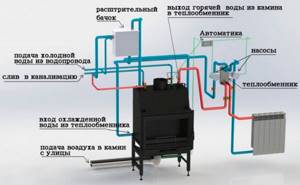
For homes with permanent residence, it is more convenient to use purified water - it is cheaper, practically does not cause corrosion in a closed heating system, and is easily topped up from the water supply if necessary. If the home is used occasionally, using water during the winter may cause the system to freeze. At the same time, the water expands and damages the elements of the system: pipes, radiators, fittings, which will subsequently lead to leaks.
In this case, you can use special antifreeze, or install an electric boiler parallel to the stove, operating in the mode of automatically maintaining a positive temperature at a level of 5-10ºC.
Fuel requirements
Any stove will not produce the efficiency indicated in the passport if it is heated with wet firewood or unsuitable wood. It is optimal to use naturally dried birch firewood in fireplace stoves with a heating circuit , which has lain in a covered woodshed or under a canopy for at least 18 months, or industrially produced briquettes with a humidity of no more than 20%.
It is not advisable to use firewood from coniferous trees - they emit a lot of resins, clog the chimney and smoke the glass in the firebox. The use of coal in fireplace stoves is generally not allowed.
Firewood can be ignited using birch bark, wood chips, paper or a special liquid. When igniting, the damper must be completely open, and access to fresh air through the ash pan must be ensured.
Furnace in the system
It is not enough to build a heating furnace with a water circuit correctly. It is also necessary to correctly develop a CO for it, and to properly include a stove in it.
Let's take a brief look at the ways of organizing CO. Whether our system will be single-pipe, 2-pipe, series, parallel or mixed is an important question, but another one from the point of view of the efficiency of using the heat of the furnace to heat the house. From the point of view of capabilities, cost, convenience, simplicity and energy independence of pairing the furnace and CO, it is more important to disassemble the systems:
- Open gravity (gravity flow).
- Open with forced circulation.
- Closed without excess pressure.
Gravity
Purely thermosiphon CO (like the internal combustion engine cooling systems of early cars) does not exist - losses in long CO pipelines will suppress thermosiphon circulation. For CO to still work, it needs to call upon a certain, quite definite share of gravity to help it (in a purely thermosiphon circulation, the share of gravitational pressure can be arbitrarily small).
The principle of operation of gravitational CO is shown on the left in the figure:

Construction of an open gravity heating system
If the system is operated from the stove in the house, it is impossible to fulfill the condition indicated in the center, even if the batteries are suspended from the ceiling. In this case, a CO with a high-mounted flow-through expansion tank (on the right in the figure) can help out; it will create the additional pressure necessary for thermosiphon circulation of the coolant. In centralized COs, a system with a flow expander is not used, because requires greater consumption of materials, labor costs for maintenance and, when used on a large scale, results in large losses of coolant. But in a private home, all this is more than compensated for by the simplicity, cheapness and stability of the operation of this CO. Its highlight is the expansion tank. The requirements for it are:
- A capacity of 200 liters is more than enough for a house up to 120-150 sq. m. m residential.
- It is convenient to make a tank from a barrel placed on the butt, i.e. vertically.
- Make-up and CO supply - only upper ones through the tank.
- The tank must be reliably thermally insulated: for circulation to occur, the water in it only needs to cool by 1-2 degrees, and heat loss from an uninsulated tank will be excessively large.
- The tank is filled halfway, like a regular expansion tank.
- To avoid evaporation of the coolant and clogging it with dust, the tank must be closed with a tight lid with thermal insulation and air drainage.
- The outlet pipe protrudes 5-7 cm above the bottom to avoid clogging the pipes with sludge.
- The mouth of the inlet pipe is located no lower than 15 cm above the outlet, but not higher than 20-25 to the water surface at its minimum level, otherwise air may be sucked into the system (water from the inlet pipe is in full swing and can be drawn into the outlet air).
Backup (emergency) electric boiler for water heating systems with a furnace
Note: since it is impossible to constantly heat a brick stove and refill CO with antifreeze, and a winter cottage with a stove can, in addition, be left for several days, it is highly advisable to include an emergency electric boiler in the system (see figure on the right). It will maintain the temperature of the water in the system above freezing; as a rule - at the level of 5 degrees Celsius. True, the backup boiler also consumes a lot of electricity per day.
With pump
Forced circulation COs are built only with metal furnaces if required by the furnace manufacturer's specifications. The intensity of heat transfer from a brick stove is too low for this: the house will be cold, the stove will get cold, and unused heat will fly away into the chimney in the form of unburned fuel.
For CO with a furnace, firstly, from the possible schemes of systems with forced circulation of coolant (see figure), you need to choose a scheme with a high-mounted expansion tank (highlighted in red). In the event of a power failure, it will provide minimal circulation to prevent the system from defrosting. If there is no backup electric boiler, the stove must be heated all the time, but little by little, so that the water in the system does not boil. Therefore, such a CO requires a supply water temperature sensor.

Schemes of open-type heating systems with a circulation pump
Secondly, the circulation pump must be equipped with a bypass (bypass in English - bypass) with a check valve, see fig. below. Without a bypass, both the system and the pump will freeze, because... the tiny thermosyphon pressure will not push water through it.
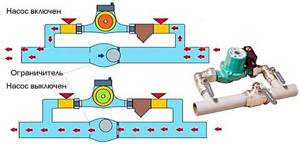
Operation diagram and appearance of the circulation pump of the heating system with bypass (bypass shunt)
Closed
Quite expensive closed COs with a membrane expansion tank are used with furnaces quite often, because they are compact, work with both metal and brick stoves and fit relatively easily into the interior of the house: the entire CO piping can be located in a cabinet next to the stove (see the figure at the beginning). The device of a closed CO operated from the furnace has no special features; It is mandatory to have an automatic or manual valve to dewater the system, see next. rice..

Construction of closed heating systems
Device Features
A fireplace stove with a built-in water circuit is a steel chamber with varying wall thicknesses . In a closed system the indicator will be 6 millimeters, in an open system - 4 millimeters.
Heat exchanger tubes are mounted between the walls to circulate the coolant liquid. To be able to control the temperature in the oven, temperature sensors are installed.
The air flow into the combustion chamber is usually adjusted manually.
PLEASE NOTE! Exterior decoration can be made using various materials in order to fully comply with the overall style of the interior.
In summer, such equipment can only be used for water heating.

How to choose and what to pay attention to?
What qualities must a heating equipment have to become a reliable source of heat?:
- Power . Varies with the size of the firebox and the dimensions of the stove. On average, a room of 10 m² requires 1 kW of power.
- Dimensions . Must fit into the installation room.
- Coolant volume . It consists of the volume of pipes and radiators, depending on the total length of the system and the number of batteries. Another 10% is added to the resulting value.
- Chimney cross section . The indicator is important for selecting suitable structural elements.
- Additional options . Cooking and heating food, easy glass cleaning, non-heating handles and other easy-to-use little things.
Rating of TOP 10 best models
In this rating, we have collected for you the best models in terms of price, quality and reliability.
La Nordica Termo Isotta
The Isotta cast iron stove is equipped with a water circuit and is designed to heat several living spaces at the same time.
Its double walls allow you to effectively manage air flow. A hob is built into the surface. It has a protective cover that protects the walls from contamination during the cooking process.
The firebox door is decorated with panoramic ceramic self-cleaning glass . There is a separate door at the bottom for easy use of the ash drawer.
Characteristics:
- power: 15-19 kW;
- Efficiency: 78.4%;
- location: wall;
- chimney: 150mm, front/rear;
- material: cast iron;
- glass type: panoramic;
- dimensions: 77.5*76*52cm;
- weight: 212kg.
Advantages:
- long burning;
- convenient door;
- self-cleaning glass;
- moderate fuel consumption.
Flaws:
- No.
META Angara Aqua
The total power of the model is 16 kW, of which 7 kW is the power of the water circuit . The heat exchanger holds 10 liters of liquid and is made of 5 mm steel. The firebox has a significant volume and is easy to clean from combustion products.
Firewood can burn in a prolonged mode, which is especially convenient at night.
The body is decorated with ceramic inserts, and the glass door provides excellent visibility..
Design solutions made it possible to reduce the volume of soot entering the chimney.
Characteristics:
- power: 16 kW;
- location: corner/wall;
- chimney: 150mm, front/rear;
- material: steel;
- heated area - up to 160m2;
- glass type: prismatic;
- dimensions: 104*70*54.5cm;
- weight: 205kg.
Advantages:
- attractive external design;
- presence of panoramic glass.
Flaws:
- high fuel consumption;
- insufficient heat transfer to the coolant;
- soot on the glass.
EdilKamin Aqua
The combustion chamber of this furnace has double walls . This allows you to reduce the temperature impact on the body and extend the service life of the fireplace stove.
The inside of the firebox is lined with fireclay, resistant to combustion products and high flame temperatures.
The door is decorated with glass, which can withstand heat up to 750 degrees, but is not resistant to pinpoint impacts . The water circuit will allow you to create a full-fledged heating system in the house, heating the neighboring rooms.
For safety, there is a built-in sensor against system overheating . The oven can be used in the kitchen; the cooking surface has a heating temperature of up to 200 degrees.
Characteristics:
- power: 6.5 kW;
- hob;
- location: wall;
- chimney: 150mm, ;
- material: steel, ceramic tiles, fireclay;
- glass type: straight;
- dimensions: 95*52*52cm;
- weight:186kg.
Advantages:
- high quality materials;
- excellent assembly;
- overheat protection.
Flaws:
- No.
Vesuvius PK-01(270) BEIGE
The stove is made of a combination of cast iron and steel . The door is cast iron with heat-resistant glass. The grate is cast iron. The firebox is finished with fireclay.
The ends are decorated with beige ceramic inserts, which help the stove retain heat longer. It is possible to heat rooms with a total area of up to 200 m2.
Burning time on one stack of wood is up to 5 hours.
High-quality components guarantee a service life of at least 10 years. The furnace firebox is 100% airtight.
The parts are fixed using a bolted connection to guarantee reliability . In the economical operating mode, the firewood only smolders; in the intensive mode, quick kindling is carried out.
Characteristics:
- power: 9 kW;
- hob - no;
- location: wall;
- heating area - up to 200m2;
- chimney: 150mm, ;
- material: steel, cast iron, ceramic tiles, fireclay;
- glass type: straight;
- dimensions: 82*46*43cm;
- weight:141kg.
Advantages:
- design;
- ergonomics;
- holds temperature for a long time.
Flaws:
- No.
Vesuvius PK-01(270) RED
The fireplace stove is made from high quality induction steel . The firebox door is made of cast iron and equipped with a glass insert; the ash door allows you to control the intensity of combustion.
The firebox is finished with high-quality fireclay, which can be easily replaced if necessary. Decorative inserts on the sides are ceramic, red.
The power is 9 kW, which will allow you to warm up a room with a volume of up to 150 m3.
One stack of firewood will provide heat for up to 5 hours. You can connect an electric fan to quickly heat the room. The minimum service life of the product is 10 years.
Characteristics:
- power: 9 kW;
- hob - no;
- location: wall;
- heating area - up to 200m2;
- chimney: 150mm, ;
- material: steel, cast iron, ceramic tiles, fireclay;
- glass type: straight;
- dimensions: 82*46*43cm;
- weight:141kg.
Advantages:
- heating rate;
- nice design in a classic style;
- high legs.
Flaws:
- soot on glass.
Choosing a furnace with a water jacket - recommendations
To choose a system that is suitable for your home, you need to consider the following parameters:
- for small structures with good insulation, a metal structure is quite suitable;
- In slightly larger buildings, consider the layout so that one installation can affect the entire building. To do this, you can try to design the heating using a water or steam circuit;
- for buildings with one floor, the circuit device is connected to both a brick and cast iron structure;
- in high-rise buildings (2, 3, 4), a cast iron stove-boiler is most suitable.

Lastly, you will have to decide on the type of fuel, since the type and final cost of the furnace equipment will depend on this.
Pros and cons of fireplaces with a water circuit
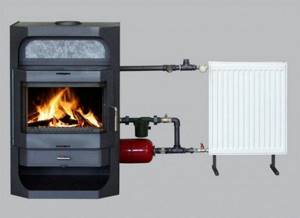
Among the advantages of fireplaces with a water circuit it is worth noting:
- System price. A ready-made stove model or custom-assembled brick fireplace will not cost that much.
- Cost of operation. The system is completely energy independent, the price of solid fuel is low, which means its use will not ruin the family budget.
- Multitasking. Such a system will decorate the interior; a separate boiler room is not required.
- A fireplace with a water circuit can be a replacement for a traditional heating system.
The disadvantages of such systems include:
- Not very high efficiency, especially when it comes to fireplaces with an open firebox. The power of such equipment may not be enough to heat the house in frosty winters.
- Lack of automation systems. It is impossible to quickly adjust the coolant temperature. You will have to add firewood or briquettes and clean the firebox manually.
Making a metal furnace
Stove heating with a water circuit in a wooden house can be made on the basis of a metal stove, although nothing prevents you from giving preference to brick. But there is less fuss with metal, and such a stove will take up minimal space. As a basis, let's take the diagram of the simplest potbelly stove and remove the internal partitions from it.

We offer you a drawing of one of the simplest, but at the same time effective metal furnaces.
These partitions are necessary for the implementation of the pyrolysis combustion scheme, but in the case of our water heating they become unnecessary. Instead, the entire internal volume will be occupied by a heat exchanger. It can be made from pipes or sheet metal - in the latter case, its area will be slightly larger, which will increase the thermal power of our unit.
To make a stove you will need sheet metal 4-5 mm thick. We cut out the walls and make a grate from the reinforcement. We mount the base, put the heat exchanger inside, and assemble the structure together. We install the chimney, connect the stove to the water heating system, fill in coolant and conduct a test run
Please note that the room in which the metal stove is located is heated by its own heat, without additional radiators
Construction of fireplaces with a water circuit
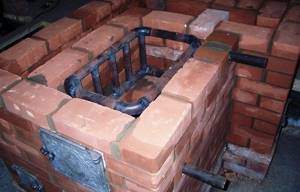
All work can be divided into two stages:
- Construction of the body of the heat source, that is, the fireplace itself;
- Installation of heat exchanger.
Construction of the fireplace body

The construction of the fireplace body should begin with the search for a formal masonry scheme. When choosing materials, give preference to those that allow you to build a fireplace with a water jacket. To ensure tightness, steel sheets are usually used.
The construction of a fireplace begins with the installation of the foundation. To fill it you will need:
- Boards for installation of formwork;
- Ruberoid;
- Crushed stone;
- Sand;
- Cement.
The size of the base should be slightly larger than the dimensions of the future fireplace. To ensure waterproofing of the finished foundation, roofing material is laid on it. After this you can start laying. Fire-resistant bricks are used for the construction of the building; the firebox is assembled from a heat-resistant fireclay grade. A special clay mixture is used as a solution. It is not recommended to make it yourself. Experts use ready-made dosage formulations.
The masonry should be assembled from horizontal main rows. At this stage, it is important to ensure accurate positioning in the horizontal plane. After this, the ash pan is assembled, then the craftsmen lay out the fireplace firebox. The final part of the installation differs significantly from the construction of a classic fireplace. At this stage, installation of the heat exchanger is required.
Heat exchanger organization
The simplest type of heat exchanger is a small tank with two flanges for connecting pipes. Cold water enters through the first pipe, heated water is discharged through the second. Due to the harmful effects of open flames, temperature changes, and the negative effects of combustion products, it will not last long. The material for the heat exchanger must be sheet steel with a thickness of at least 4 mm.
The exact dimensions of the tank are determined by the design of the fireplace. To increase efficiency, it is recommended to use coil-type heat exchangers. Such designs consist of sections and registers, assembled in the form of a labyrinth.
After the heat exchanger is manufactured, it is built into the body of the fireplace. After this, special stands are formed on which the tank will rest. Installation is carried out in such a way that the heat exchanger flows are outside the fireplace. This allows for repairs in the event of a breakdown.
After installing the heat exchanger, the assembly of the fireplace fuel chamber is completed. It is covered with masonry with the obligatory organization of a smoke hole. Finally, a chimney is erected.
After the masonry has completely dried, which will take at least 10 days, the system can be filled with water for the first time. During initial start-up, it is necessary to check for leaks. In an open system, leaks lead to a decrease in the volume of water, but in a closed system they will cause a lack of circulation.
If the fireplace will be used as a backup heat source, a system must be provided for turning on and off the circuits from it. Using a bypass valve allows you to stop the water supply.
Copper
Such a coil is quite effective, because its thermal conductivity is considered very good. But it has one significant drawback - the melting point is 1083 °C. When using the unit in compliance with the established rules, you do not have to worry about rendering the device unusable. But in emergency and unforeseen circumstances, the heat can reach 1200°C. And the condensate that appears during cooling contains admixtures of dangerous chemical compounds that lead to the formation of corrosion. Therefore, installing this type of heat exchanger in brickwork is strictly prohibited.
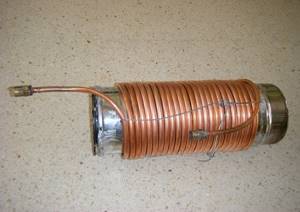
Cast iron
They are very susceptible to rusting, have increased fragility, and thermal changes that occur during cooling and heating cause cracks to appear, which leads to failure of the heat exchanger. The cast iron register, due to insufficient processing of the metal, is constructed from cast parts, which reduces its reliability. Another disadvantage that can be noted is its heavy weight.
Steel
Heat exchangers made of such material are more common due to its availability, as well as the possibility of using any processing. According to the recommendations, the circuits are made of heat-resistant steel measuring from 3 to 5 mm, using pipes without seams.
Made of stainless steel
The cost of such a heat exchanger is at the level of previous options, but in terms of operational characteristics the device exceeds them.
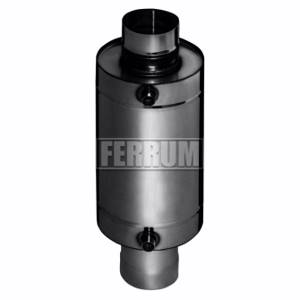
They are ideal for baths, wooden houses and cottages, as they have special protection from high temperatures, which increases their service life.
Heating distribution systems
When organizing a heating distribution system, it is worth considering that they come in two varieties: open and closed.
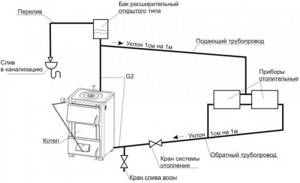
In the first case, water circulation occurs due to the inclination of the pipeline. Heated water is supplied to the highest point. After this, it passes through the entire pipeline by gravity. The level gradually decreases. Water returns to the boiler through a pipe called return. An expansion tank is installed in the attic to allow for expansion as temperatures increase. The heated water is forced into the expansion tank; with gradual cooling, the reverse process is observed.
The main advantage of an open system is its simplicity. Installation can be done independently. However, it is not suitable for heating a large area.
A more complex water heating system using wood
It is a pyrolysis boiler. which consists of two sections. In the lower section, firewood is burned, and in its upper part, the gas generated during combustion circulates. Due to the fact that in this design, gases do not immediately enter the chimney, its efficiency is higher, and such a boiler consumes less firewood.
It is tied with thick-walled pipes through which water circulates, heated by the boiler.
It is necessary to take into account that for the normal functioning of such a boiler, it is necessary to use only dry firewood. If the farm has a pyrolysis boiler, then there should also be a supply of well-dried firewood.
There are systems that use hot air rather than water for heating. It passes along the circuit and is supplied to the living quarters. Cooled air, according to the physical law of convection, falls down, enters special air intakes and again enters the boiler.
Advantages of fireplace stoves
Among the main advantages of using such equipment, several points stand out.
- Creating a pleasant indoor environment.
- High heating rate.
- Possibility to combine with existing heating systems.
- Arrangement almost anywhere, the main thing is to comply with fire safety rules.
- Easy to use with heat exchangers, absolute autonomy.
- Work from an accessible and inexpensive type of fuel.
- Multifunctionality. This is both a heating device and equipment for cooking.
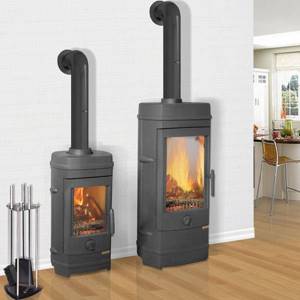
Principle of operation
The unit is a hybrid of a conventional stove, boiler and fireplace. The circuit for heating water can be made of separate register pipes located in the firebox or along the walls. Another alternative is that the coolant circulates inside two partitions in the housing; this design is called a “jacket”.
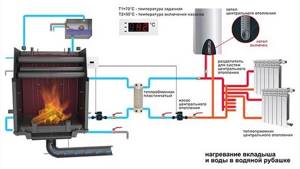
Less often, a water heating tank is placed in the upper part; this is a less effective solution.
Each element is directly connected to the overall space heating system. Due to thermal conductivity, you can warm several rooms at once.

Such devices operate according to the same algorithm, since they are aimed not only at providing housing with heat, but also with hot water supply.
- The boiler heats the liquid, which flows through pipes using electric pumps.
- The cooled coolant is returned for further heating.
Types of ovens by heating method
Stoves for water heating at home operate on wood, coal, peat, and eurowood. Depending on the type of camera, they differ in size and are divided into portable and stationary. In appearance, oven doors come with rectangular, slotted, round and shaft connectors. Furnaces may also have one or two operating compartments.
Single chamber
They are suitable for small spaces, quickly warm up the space, are affordable and do not require special knowledge to operate.
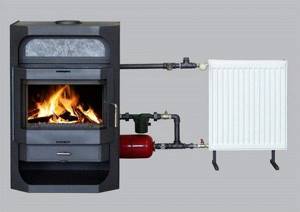
Double chamber
The lower and upper parts work on the principle of self-sufficiency. In the basement section, fuel burns, transforming into gas, which rises and combines with oxygen. This system allows you to save on fuel, while maintaining the maximum level of efficiency.
Convection
The functioning of the model is ensured by air circulation, so the cold flow coming from below is heated to high temperatures from above. Quick heating of the room, but also the same cooling.
Review of popular models
The easiest to install and connect are considered to be free-standing devices made of steel and cast iron with a built-in heat exchanger. They can be located in a double housing, creating a water jacket around the camera, or located in the upper part of it. The pipes brought outside are simply connected to the heating circuit. For the heating device itself, it is enough to find a convenient place in any area of the room where the chimney can be removed. The main thing is not to forget to cover the floor with a metal screen over a non-flammable coating (minerite sheet, for example).
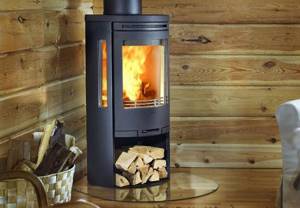
Stove-fireplace AQUA
They are made of steel in the form of 5 mm plates. The transverse edge and chambers are covered with heat-resistant tiles, which can be replaced if damaged.
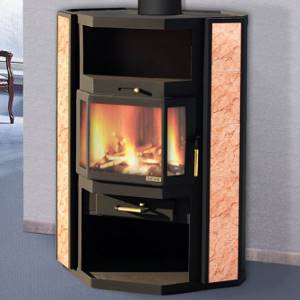
The product includes a tempered glass door for viewing. There is a niche for firewood at the bottom.
Specifications:
- energy supply ranges from 13 to 16 kW;
- the circuit gives a power indicator of 5-7 kilowatts;
- steel heat exchanger;
- designed for wall installation;
- the lining of the side walls is made of ceramics;
- the front panel has panoramic heat-resistant glass;
- chimney diameter – 150 mm.
Even if there is no connection to the heating system, the ability to warm up the space is not lost. Only this method increases wear. It is imperative to fill the circuit with water when turning it on, otherwise the elements will be damaged and they will fail.
Bavaria fireplace stove
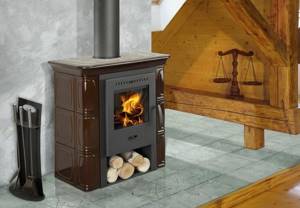
Manufactured from steel sheets, complemented by a cast iron grate to separate the firebox and ash pan. Experts note good technical characteristics:
- compact size - the device is suitable even for small spaces:
- mobility – the fireplace stove can be moved from one place to another at the owner’s discretion;
- the units are easy to install and use;
- strong heat-resistant glass ensures safety by reducing the risk of flame entering the room;
- warm-up speed is very high;
- fairly high productivity (efficiency - 80%);
- environmental friendliness - carbon dioxide emissions are reduced and barely reach 0.20%;
- if you purchase a model that has a built-in hob and oven, you can cook food over an open fire by first removing the cast iron rings from the burners;
- Externally the devices are very attractive.
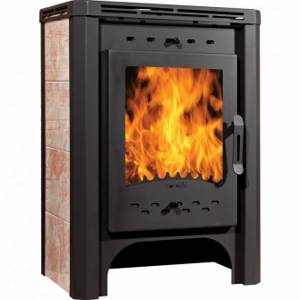
Devices with a water circuit are connected to pipes in all rooms of the house. On top of the chamber or in the partitions of the stove there is a heat exchanger with a coil through which the liquid coming from the distribution tank moves. On both sides, pipes diverge along the edges to supply cold and hot water, which have the property of removing boiling water that gets into the heating system. To determine whether the stove will perform its functions fully, you need to evaluate the power factor.
Types of heating system diagrams for furnaces
This design must be equipped with taps for draining liquid. This must be done before the onset of cold weather, since frozen water can damage the device. An alternative is the initial use of antifreeze as a liquid substance.
Let us consider in detail each of the three types of structures.
Open
A classic design that operates on the principle of natural circulation, that is, due to the different densities of cold and hot water substances. Suitable for small buildings.
It is installed according to the traditional plan - an accelerating pipe with a height of more than 2.5 m and a diameter of 50 mm begins from the stove. An open type expansion tank is placed on top.
There should be a slope of 30 degrees from the upper outlet of the heat exchanger to the tank to avoid water hammer. The return outlet is placed in a horizontal position, then a drain is made to empty the heat exchanger.
In this case, the circumference must be more than 32 mm. The recommended material in the connection area to the furnace is only steel or copper.
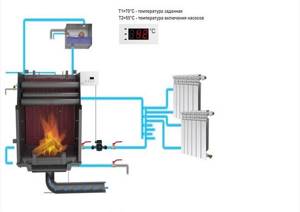
Closed
It includes the mandatory installation of a pump for circulation and recirculation, a storage tank, a pressure gauge or thermomanometer, an automatic air vent and a safety valve.
In addition, there is a possibility of installing a heat exchanger, which significantly increases the overall efficiency, regulates the thermal regime, and accumulates heat during circular operation of the stove.
The piping is also supposed to be made of metal pipes.
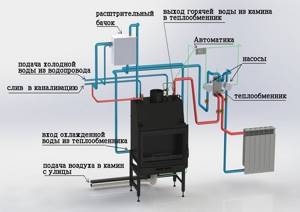
Combined
Is the most preferred solution. Artificial heating of premises is carried out according to the rules of natural circulation of liquids. An auxiliary reserve supply is provided using a circulation pump. In cold weather, such a design will serve as a heater in the rooms of the house, and will allow you to cook food without the use of other energy consumers.

Water circuit connection
You can connect the fireplace to the existing heating system in the house. Pipes for water supply and drainage, as well as a chimney pipe, are connected to the fireplace. If it is necessary to heat the floor for a private house, additional pipes for water circulation are installed in the boiler.
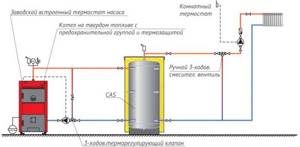
When connecting the water circuit, the following important points must be observed:
When connecting the water circuit, the following important points must be observed:
- installation on a flat surface. If it is not possible to level the floor on which the fireplace will stand, you can use adjustable legs. Uneven installation entails operating hazards and a significant reduction in the efficiency of the fireplace;
- mandatory check for leaks after filling the system with water. First, you should check all pipe joints without applying pressure. Then, turning on the circulation pump, once again eliminate leaks and leaks in pipes and joints. It is also necessary to ensure the tightness of the chimney by covering the joints with heat-resistant sealant;
- checking the operation of the fireplace and water heating. Do not be alarmed by the smell from the fireplace when you first light it - it will disappear within a short time. It is necessary to check the correct operation of the automation: how accurate is the regulation of the water temperature in the radiators, is it possible to regulate the speed of its supply.

Installation of stoves for a home with a water heating circuit - step-by-step instructions
In order to avoid the unpleasant consequences of improper assembly of the stove and heat exchanger, it is better to involve a specialist installer. He will take into account all the subtleties:
- Fire safety rules. It is necessary to protect the walls around the installation from fire with non-combustible materials.
- Assembling the chimney is the next step. Excellent configuration options can be purchased from the manufacturer Ferrum.
- A special gap of five millimeters, which is left when installing pipes, must be filled with a suitable heat-resistant sealant.
- Under no circumstances should the structure be walled up closely; it is necessary to leave a gap of 10/15 mm between it and the walls to compensate for thermal expansion.
- Afterwards, the equipment is checked and the heating device is installed (the heat exchanger must undergo a strength test with hydraulic or pneumatic pressure of six bar).
- In conclusion, the master connects all components of the structure and checks its readiness.
Operating rules
To ensure continued operation of the heating system, we recommend following the following procedure:
- Do not disconnect the radiator from the device during operation. Water expands when heated, and the increased pressure can cause an explosion.
- If the heat exchanger is already hot, do not allow cold liquid to enter the system, as the temperature difference leads to deformation and damage.
- Do not use an empty heat exchanger to avoid burnout.
- To increase productivity, a circulation pump should be used.
- Use antifreeze if necessary.
- Place the drain valve at the lowest point.
To extend the service life of the heat exchanger, it is recommended to select a unit with a higher power than you calculated according to the existing parameters. This will help reduce the stress that will occur if the furnace is forced to operate at its maximum capacity. This strategy will reduce wear on parts.
To ensure that the heating system functions smoothly, follow the operating instructions.
Installation and installation
You should entrust the installation work to specialists and not take risks by installing it yourself.
- After a thorough inspection of the fireplace, you should ensure the integrity of the parts and the strength of the connections.
- The device is installed on a 30-40 cm foundation.
- The device should be leveled and connected to the chimney ducts and water system. According to consumer reviews, this procedure is not difficult.
- The next step is the installation of the components, according to the instructions for each individual model, which can be seen in the video.
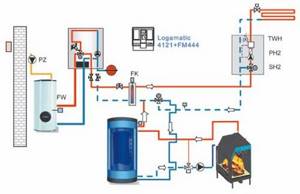
The standard connection model for most fireplaces with a water jacket is approximately the same:
- install the fireplace itself in the basement or living room;
- a hydraulic accumulator is installed in the utility room,
- Radiators are installed along the internal perimeter of the house to heat the room.

The placement of the expansion tank changes the type of system, which, depending on its location, can be closed or open:
- An open system is characterized by placing the expansion tank at the highest point of the room; the heat exchanger, located in the free part of the firebox, is located in the coil and is filled with water under the influence of gravity. Such a system is simple, you can easily install it yourself, but due to the large energy loss of water and the high hydraulic pressure of the pipes, it is ineffective.
- With a closed system, the heat exchanger is located in the closed part of the fireplace, and a pump is used to circulate water in the system. Water boils when circulation stops, causing an emergency shutdown of the equipment. Such a system is much more difficult to assemble yourself
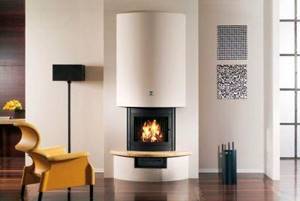
To prevent this phenomenon, an additional coil is installed in the rear of the device, which is filled with cold water if necessary. A water temperature sensor is built into the water jacket of such fireplaces, and if it overheats, the system automatically turns off.
How the system works
The simplest water circuit is with natural circulation of water flow. Its basis is a simple physical phenomenon: the expansion of liquids when they are heated. The unit that creates pressure is an expansion tank (a container for collecting water), installed in the attic or attic.
The water circuit is a closed system. The boiler heats the water in it and, expanding, it is directed through a pipe into a storage tank. The movement is carried out under pressure created by the cooled water constantly entering the boiler and passing through the entire system. Boiling water from the expansion tank is directed by gravity down through the pipes leading to the batteries. Having given off the heat, it returns to the tank and heats up again.
Installing a pump will help to significantly increase the pressure in the system and speed up the circulation of the coolant. At average outdoor temperatures, it can be turned off and the circuit will function on the natural movement of water. This will save you on your energy bills. Water enters the pump with the check valve closed. By turning it off (leaving it open), the entire volume of coolant is directed to bypass the pump.
Such a stove can be loaded not only with wood or coal. When using alternative fuels, it is possible to complicate the structure of the system by adding:
- granule storage tank;
- a mechanism that feeds pallets into the firebox (pneumatic or auger).
You can make the operation of the furnace easier by installing an automatic system for regulating its operation and forced ventilation.
Types of water furnaces
- installations running on traditional wood. Let us make a reservation that such fireplaces should not be too productive, since failure of the fireplace is inevitable earlier than necessary.
- The Buleryan stove is different in that it does not require the installation of a special register for heating the coolant. In Buleryan, water or antifreeze is heated in the furnace itself, and to increase the productivity of the device, an additional compartment is provided where wood gas is supplied.
- Heat stoves made of durable cast iron are devices based on a cast iron body where heat is produced. Very good stoves, in simple terms, they are bought “for centuries”, since cast iron is one of those materials that have high durability and reliability of their use. Only the water body in the device is made of thermal steel, everything else is cast iron.
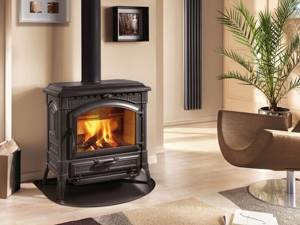
- the simplest: by reducing or increasing the portion of fuel, they affect the decrease or lowering of the temperature mark.
- To transform temperature conditions, a special damper-regulator is used.
- The use of a circulation pump affects the rhythmic heating of the house.
Sources
- https://domspechkoy.ru/pech-kamin-s-vodyanym-konturom/
- https://gidpopechkam.ru/kaminy/pech-kamin-s-vodyanim-konturom.html
- https://expert-dacha.pro/otoplenie/pechi/pechi-kaminy/s-vodyanym-konturom-otopleniya.html
- https://zapodlico.ru/kak_organizovat_kamin_s_vodyanym_konturom_otopleniya_plyusy_i_minusy
- https://feflues.ru/blog/kaminy/pech-kamin-s-vodyanym-konturom-dlya-otopleniya-doma/
- https://www.tproekt.com/kamin-s-vodanym-konturom/
[collapse]
Features of brick kilns
All types of structures of this type have been known for several hundred years and have long proven their reliability. But when giving preference to such heating, you need to weigh the pros and cons.
What's good about this option?
- If you try to heat a house using a conventional solid fuel stove, then on average 1 m² of construction can heat 30 m² of a standard house with ceilings up to 3 m. Accordingly, it turns out that the larger the house, the larger the stove needs to be built. A system with built-in water registers generates 2.5 times more heat and can have a fairly modest size.
- If the instructions for laying the structures were carried out in accordance with all requirements, then the stove will serve faithfully for decades. Preventive inspection and cosmetic repairs are within the power of any owner, unlike the option with a solid fuel boiler.
The principle of register heating.
- At the moment, there are several common projects; if a Russian stove is not suitable for every room, plus its installation requires high qualifications, then Swedish or Dutch brick stoves with water heating can be built with your own hands, if you really want to.
- Another positive aspect of such heating is that in this case it is not at all necessary to build complex multi-channel structures; if there is no question of the presence of a frying surface, then such a system can be mounted on the basis of a conventional fireplace.
Important: if the maximum efficiency of a traditional brick structure does not exceed 50%, then using good registers, proper piping and a heating circulation pump embedded in the system. Efficiency can reach up to 85%, which is quite comparable with modern solid fuel boilers
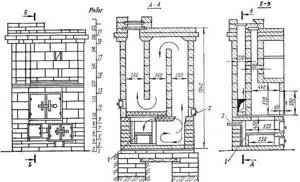
Scheme of a stove with a heating boiler.
- The price of building materials and fuel plays an important role. The structure itself can be made from material left over after the construction of the house. As for fuel, firewood, coal or briquettes are not exorbitantly expensive types and are quite affordable for almost everyone.
- Most designs are equipped with a frying surface and an oven, which allows you to cook food at the same time.
System flaws
It will take time to run the system at its designed capacity; unlike electrical units, it will take at least half an hour to heat up the brick walls of the structure and the coolant in the pipework.
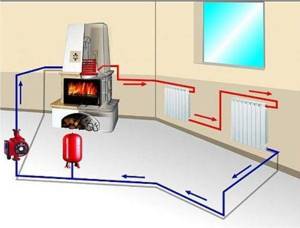
Heating diagram from a fireplace.
- When compared with solid fuel boilers of comparable power, the dimensions of such structures will be much larger. Plus, they usually need to be installed in the center of the home, which takes up quite a lot of usable space.
- Any solid fuel heating system provokes the formation of quite a large amount of dust. No matter how hard you try, you will need to clean the room where the brick oven is installed much more often.
- All structures of this type are classified as objects of increased fire danger. They cannot work offline. In addition to the possibility of a fire, there is also the danger of carbon monoxide spreading due to improper operation or boiling of the coolant in the system, which is also fraught with unpleasant consequences.
